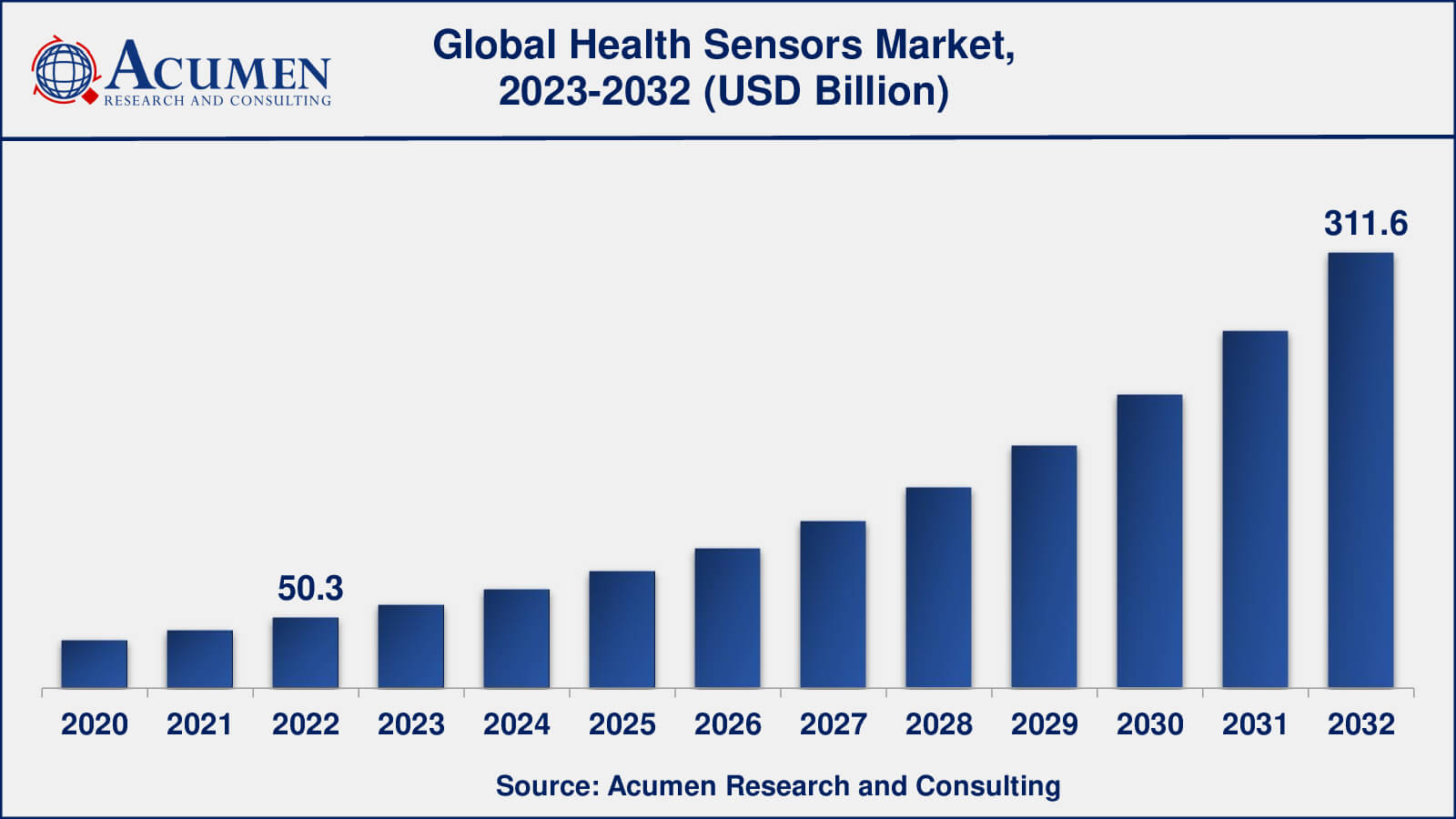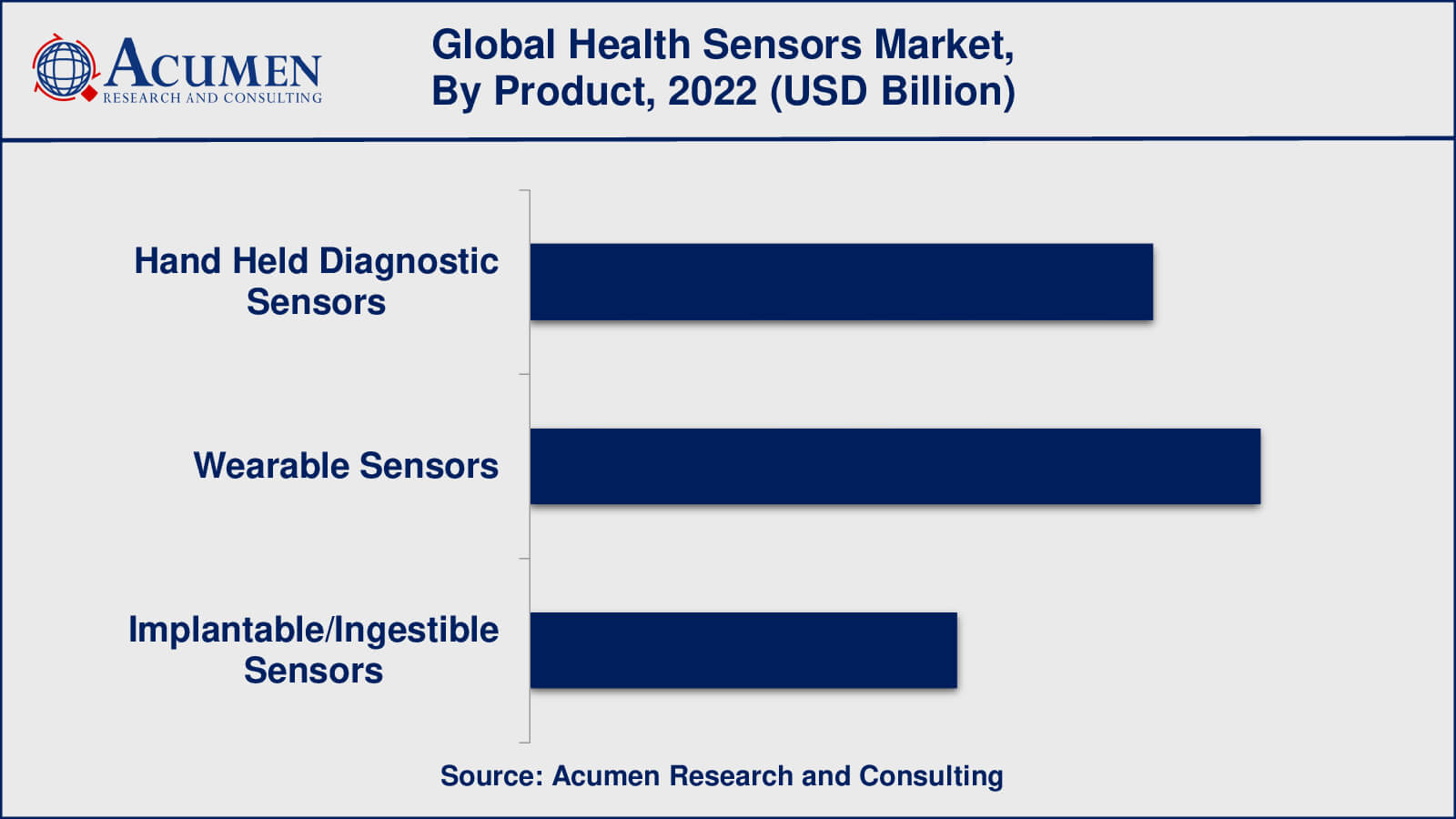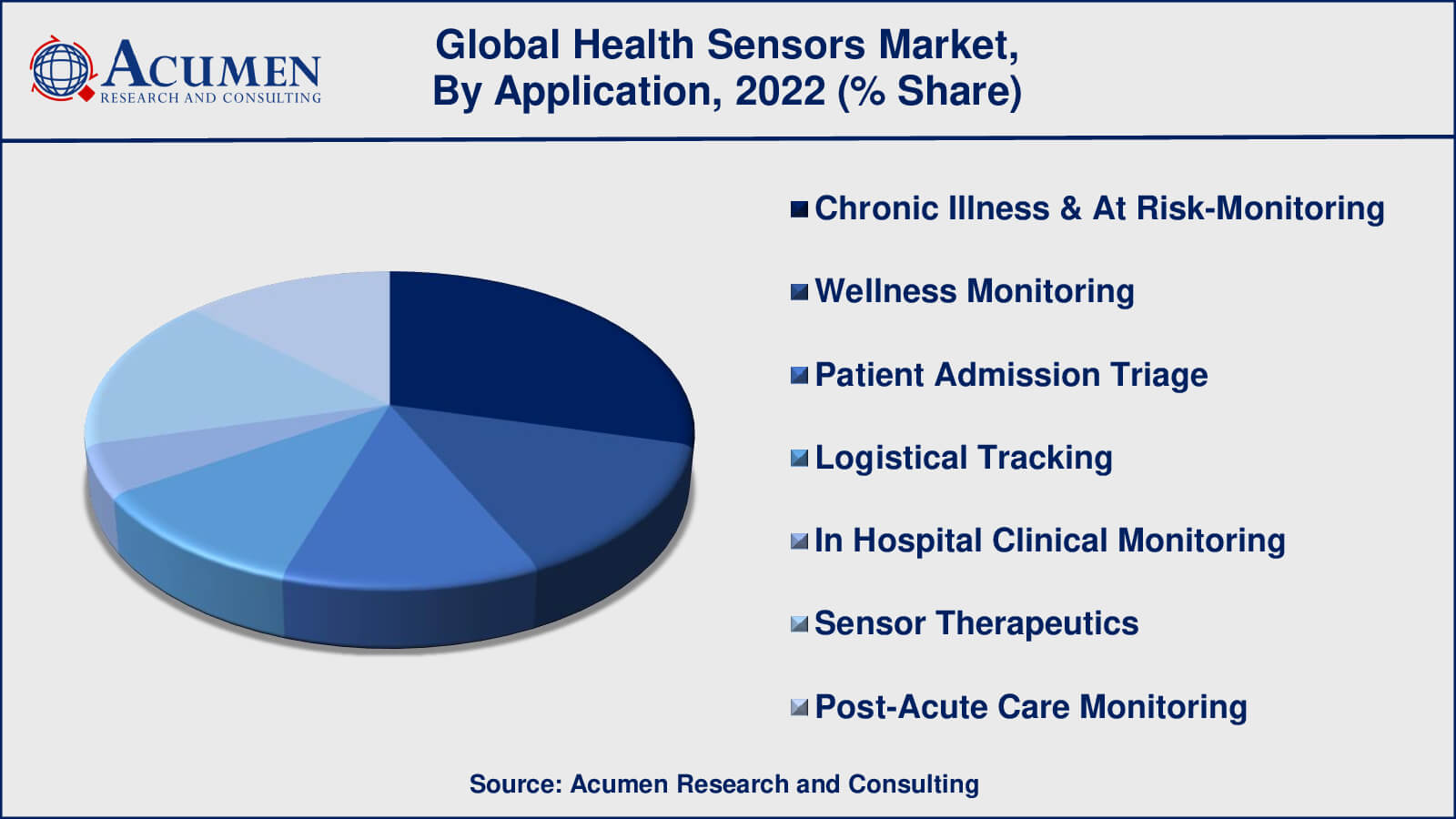Health Sensors Market | Acumen Research and Consulting
Health Sensors Market Size - Global Industry, Share, Analysis, Trends and Forecast 2023 - 2032
Published :
Report ID:
Pages :
Format :
The Global Health Sensors Market Size accounted for USD 50.3 Billion in 2022 and is estimated to achieve a market size of USD 311.6 Billion by 2032 growing at a CAGR of 20.2% from 2023 to 2032.
Health Sensors Market Highlights
- Global health sensors market revenue is poised to garner USD 311.6 billion by 2032 with a CAGR of 20.2% from 2023 to 2032
- North America health sensors market value occupied more than USD 18.1 billion in 2022
- Asia-Pacific health sensors market growth will record a CAGR of more than 21% from 2023 to 2032
- According to the International Diabetes Federation, the number of diabetics worldwide will reach 783 million by 2045
- Among product, the wearable sensors sub-segment generated over US$ 20.6 billion revenue in 2022
- Based end-user, the chronic illness & at risk-monitoring sub-segment generated around 29% share in 2022
- Development of smart implants is a popular health sensors market trend that fuels the industry demand

Health sensors are electronic devices that measure and monitor various vital signs, parameters, and activities related to a person's health and well-being. Health sensors capture and transmit data that can be used to track and analyze health conditions, detect changes in vital signs, and offer real-time insights to patients and healthcare providers using various technologies such as sensors, wearables, implantables, and ingestibles.
Chronic illness and at-risk monitoring, wellness monitoring, patient admission triage, logistical tracking, in-hospital clinical monitoring, sensor therapeutics, and post-acute care monitoring are just a few of the applications for health sensors. Medical sensors have the potential to improve healthcare outcomes by allowing patients and healthcare providers to more effectively track and manage health conditions, detect changes in vital signs before they become difficult, and provide real-time insights that can aid in the prevention of medical emergencies.

Global Health Sensors Market Dynamics
Market Drivers
- Increasing incidences of chronic disorders
- Growing adoption of wearable devices
- Government initiatives and funding
- Emphasis on data privacy and security
Market Restraints
- High cost of devices
- Data privacy and security concerns
- Limited reimbursement policies
Market Opportunities
- Growing demand for remote patient monitoring
- Increasing adoption of telemedicine
- Rising demand for personalized healthcare
- Expansion of the Internet of Things (IoT)
Health Sensors Market Report Coverage
| Market | Health Sensors Market |
| Health Sensors Market Size 2022 | USD 50.3 Billion |
| Health Sensors Market Forecast 2032 | USD 311.6 Billion |
| Health Sensors Market CAGR During 2023 - 2032 | 20.2% |
| Health Sensors Market Analysis Period | 2020 - 2032 |
| Health Sensors Market Base Year | 2022 |
| Health Sensors Market Forecast Data | 2023 - 2032 |
| Segments Covered | By Product, By Application, And By Geography |
| Regional Scope | North America, Europe, Asia Pacific, Latin America, and Middle East & Africa |
| Key Companies Profiled | Abbott Laboratories, Analog Devices Inc., Avago Technologies Ltd., Danaher Corp., GE Healthcare, Hologic, Honeywell International Inc., Koninklijke Philips, Medtronic Plc., Roche, Sensirion AG, Smith’s Medical Inc., Stryker Corp., and Varian Medical System. |
| Report Coverage |
Market Trends, Drivers, Restraints, Competitive Analysis, Player Profiling, Covid-19 Analysis, Regulation Analysis |
Health Sensors Market Insights
Several factors are expected to drive significant growth in the medical sensors market in the coming years. To begin with, the increasing prevalence of chronic diseases such as diabetes, cardiovascular disease, and respiratory disorders has increased demand for health sensors to monitor and manage these conditions. With an ageing population and a greater emphasis on preventative healthcare, demand for health sensors is expected to rise further.
Second, technological advancements in the field of health sensors are propelling the market forward. The advancement of advanced sensors with greater accuracy, longer battery life, and wireless connectivity improves patient outcomes and makes healthcare more accessible. AI and ML integration in health sensors has also improved their ability to provide real-time data analysis, increasing their overall effectiveness. Third, as wearable devices such as smartwatches and fitness trackers become more popular, the use of health sensors for personal health monitoring has increased. These devices are gaining popularity among the younger generation, fueling demand for health sensors.
Despite the numerous growth drivers in the health sensors market, several restraints are impeding market growth. The high cost of devices is one of the most significant constraints. Health sensors and associated devices can be costly, limiting their availability, particularly in developing countries. This may limit their uptake and slow market growth. Another significant impediment is the lack of reimbursement policies for health sensors and related devices. This is especially true in emerging markets, where governments have yet to implement policies that encourage the use of these devices. Health sensors may be less accessible to low-income patients due to a lack of reimbursement policies.
Concerns about data privacy and security are another major impediment to the growth of the health sensors market. Health sensors produce an enormous quantity of personal data that can be used to identify patients and reveal sensitive health information. Concerns have been raised about data privacy and security, especially in light of recent high-profile data breaches. Patients may become hesitant to use health sensors as a result, further limiting their adoption.
Health Sensors Market Segmentation
The worldwide market for health sensors is split based on product, application, and geography.
Health Sensor Products
- Hand Held Diagnostic Sensors
- Implantable/Ingestible Sensors
- Wearable Sensors
- Disposable Wearable Sensors
- Non-Disposable Wearable Sensors

As per the health sensors industry analysis, wearable sensors are presently the most popularly used and popular product type in the market. Wearable sensors are popular for personal health monitoring and fitness tracking because they are small, easy to use, and can monitor a variety of vital signs. Furthermore, the trend towards home-based health monitoring, as well as the growing popularity of wearable devices such as smartwatches and fitness trackers, is propelling the wearable sensors market forward. Hand-held diagnostic sensors and implantable/ingestible sensors, on the other hand, play important roles in the health sensors market and are anticipated to grow in the coming years, especially for medical and clinical applications.
Health Sensor Applications
- Chronic Illness & At Risk-Monitoring
- In Hospital Clinical Monitoring
- Logistical Tracking
- Patient Admission Triage
- Post-Acute Care Monitoring
- Sensor Therapeutics
- Wellness Monitoring

According to the health sensors market forecast, the chronic illness & at-risk monitoring application will dominate the market from 2023 to 2032. Diabetes, cardiovascular disease, and respiratory disorders are common worldwide, and the use of health sensors to monitor and manage these conditions is becoming more popular. Health sensors can monitor a variety of vital signs and parameters, such as blood glucose levels, heart rate, respiratory rate, and blood pressure, and provide real-time data and insights that can aid patients and healthcare providers better manage these chronic conditions. Furthermore, the rising prevalence of chronic diseases, combined with an ageing population and a greater emphasis on preventative healthcare, is propelling the chronic illness and at-risk monitoring application in the health sensors market forward.
Health Sensors Market Regional Segmentation
North America
- U.S.
- Canada
Europe
- U.K.
- Germany
- France
- Spain
- Rest of Europe
Asia-Pacific
- India
- Japan
- China
- Australia
- South Korea
- Rest of Asia-Pacific
Latin America
- Brazil
- Mexico
- Rest of Latin America
The Middle East & Africa
- South Africa
- GCC Countries
- Rest of the Middle East & Africa (ME&A)
Health Sensors Market Regional Analysis
North America is currently the biggest market for health sensors, owing to factors such as the high prevalence of chronic diseases, rising wearable device adoption, and rising demand for home-based health monitoring. The presence of a well-established healthcare infrastructure, as well as favourable reimbursement policies, is also contributing to the growth of the North American health sensors market.
The Asia-Pacific region is expected to experience significant growth in the health sensors market, owing to factors such as a large population, rising health and fitness awareness, and rising disposable incomes. The growing emphasis on digital health and the increasing adoption of wearable devices are also driving market growth in the region.
Health Sensors Market Players
Some of the top health sensors companies offered in the professional report includes Abbott Laboratories, Analog Devices Inc., Avago Technologies Ltd., Danaher Corp., GE Healthcare, Hologic, Honeywell International Inc., Koninklijke Philips, Medtronic Plc., Roche, Sensirion AG, Smith’s Medical Inc., Stryker Corp., and Varian Medical System.
Frequently Asked Questions
What was the market size of the global health sensors in 2022?
The market size of health sensors was USD 50.3 billion in 2022.
What is the CAGR of the global health sensors market from 2023 to 2032?
What is the CAGR of the global health sensors market from 2023 to 2032?
Which are the key players in the health sensors market?
The key players operating in the global market are including Abbott Laboratories, Analog Devices Inc., Avago Technologies Ltd., Danaher Corp., GE Healthcare, Hologic, Honeywell International Inc., Koninklijke Philips, Medtronic Plc., Roche, Sensirion AG, Smith’s Medical Inc., Stryker Corp., and Varian Medical System.
Which region dominated the global health sensors market share?
North America held the dominating position in health sensors industry during the analysis period of 2023 to 2032.
Which region registered fastest CAGR from 2023 to 2032?
Asia-Pacific region exhibited fastest growing CAGR for market of health sensors during the analysis period of 2023 to 2032.
What are the current trends and dynamics in the global health sensors industry?
The current trends and dynamics in the health sensors industry include increasing prevalence of chronic diseases, growing adoption of wearable devices, government initiatives and funding, and rising use of health sensors in clinical trials
Which product held the maximum share in 2022?
The wearable sensors product held the maximum share of the health sensors industry.



